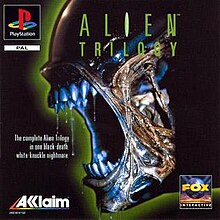
Hexen: Beyond Heretic is a fantasy first-person shooter video game developed by Raven Software and published by id Software distributed through GT Interactive on October 30, 1995. It is the sequel to 1994's Heretic, and the second game in Raven Software's "Serpent Riders" trilogy, which culminated with Hexen II. The title comes from the German noun Hexen, which means "witches", and/or the verb hexen, which means "to cast a spell". Game producer John Romero stated that a third, unreleased game in this series was to be called Hecatomb.

Area 51 is a light gun arcade game released by Atari Games in 1995. It takes its name from the military facility. The plot of the game involves the player taking part in a Strategic Tactical Advanced Alien Response (STAAR) military incursion to prevent aliens, known as the Kronn, and alien-created zombies from taking over the Area 51 military facility.
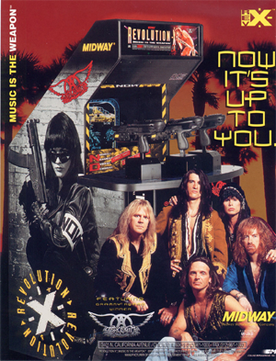
Revolution X is a shooting gallery video game developed by Midway and released in arcades in 1994. The gameplay is similar to Midway's earlier Terminator 2: Judgment Day, but is themed around the band Aerosmith. The oppressive New Order Nation regime and their leader Helga have abducted Aerosmith, and players use a mounted gun to control onscreen crosshairs and shoot enemies. The members of Aerosmith are hidden throughout the game's international locales and must be found in order to receive the game's true ending.

Corpse Killer is a horror-themed rail shooter developed and published by Digital Pictures for the Sega CD, Sega CD 32X, 3DO, Sega Saturn, Windows 95 and Macintosh computers. An interactive variation on the zombie film genre, it utilizes live-action full motion video in a format similar to other games developed by Digital Pictures. Reviews for the game were mixed, generally criticizing the repetitive gameplay and low video quality, though many reviewers enjoyed the campy nature of the cutscenes. Corpse Killer was the first CD game released for the Sega 32X. It was later remastered for Steam, PlayStation 4 and Nintendo Switch.

Die Hard Trilogy is an action video game developed by Probe Entertainment, published by Fox Interactive and distributed by 20th Century Fox Home Entertainment in North America and Electronic Arts in Europe for the PlayStation, Sega Saturn and Microsoft Windows. The game is based on the first three installments of the Die Hard series of action movies, with each film entry being represented through a different gameplay genre.

Batman Forever: The Arcade Game is a beat 'em up video game based on the movie Batman Forever. The subtitle is used to differentiate it from Batman Forever, another beat 'em up published by Acclaim at around the same time. One or two players, playing as Batman and Robin, fight Two-Face, the Riddler, and numerous henchmen.
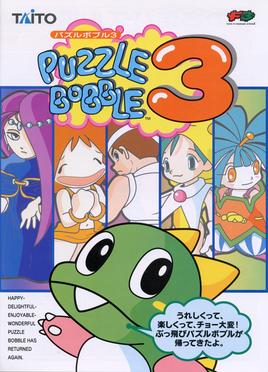
Puzzle Bobble 3 is an action puzzle video game developed by Taito. The second sequel to Puzzle Bobble, it was released for arcades in September 1996 and later ported to the Sega Saturn, PlayStation, Game Boy, Nintendo 64 and Microsoft Windows. Like its predecessors, the player is tasked with shooting balls at groups of balls, creating groups of three or more, which are then removed from play. Further ports for the Nintendo Switch, PlayStation 4 and Xbox One were released in February 2023 by City Connection alongside Puzzle Bobble 2.
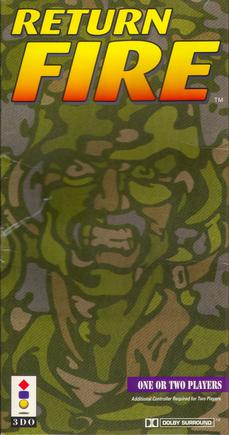
Return Fire is a 1995 video game developed by Silent Software, Inc. for the 3DO Interactive Multiplayer and ported to the PC and PlayStation in 1996. It was preceded by Fire Power (1987) and followed by Return Fire 2 (1998). An expansion pack, Return Fire: Maps O' Death, was released for the 3DO in 1995. Return Fire is a vehicular shooter from a 3D bird's eye view, in which the player's goal is to capture the enemy flag and return with it to their base. It was met with critical acclaim for its unusual gameplay concept, enjoyable multiplayer mode, and classical soundtrack, and is remembered as one of the 3DO's "best games" in its Home of the Underdogs entry.

X2 is an arcade-style side-scrolling shoot 'em up released during the Team17-Ocean collaboration era of video games that created the Worms series. It is the sequel to the Amiga shooter Project-X. Unlike its predecessor, this game was a console exclusive. Acclaim Entertainment was slated to publish the game in North America, but it was never released in that region. A Sega Saturn version of the game was scrapped during development, at least in part due to Acclaim withdrawing support for the Saturn.

Iron Man / X-O Manowar in Heavy Metal is a video game published by Acclaim Entertainment and developed by Realtime Associates for the PlayStation, Sega Saturn, Game Boy, Game Gear, and MS-DOS in 1996. It is a one or two-player side-scrolling action game in which the player battles villains from Marvel Comics' Iron Man and Valiant Comics' X-O Manowar comic book series. It was met with negative reviews which criticized it for dull gameplay and outdated graphics.

Robotica, also known as Robotica Cybernation Revolt in Europe and Deadalus (ダイダロス) in Japan, is a first-person shooter which was released for the Sega Saturn in 1995.
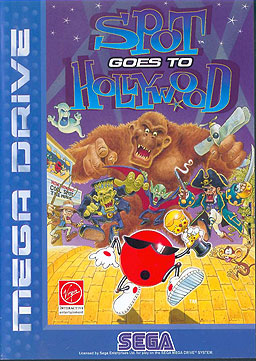
Spot Goes to Hollywood is a platform game developed by Eurocom and published by Acclaim Entertainment in North America and Virgin Interactive Entertainment in Europe for the Mega Drive/Genesis as the sequel to Cool Spot. Saturn and PlayStation versions were later released with full motion video clips and isometric graphics. The player controls Spot, once the mascot for the 7 Up soft drink, as it travels to various places trying to free its friends.

Loaded is a science fiction-themed top-down multidirectional shooter developed by Gremlin Interactive and published by Interplay Productions. Loaded was released on December 15, 1995 on the PlayStation, and was ported to the Sega Saturn the following year. The game had origins in DC Comics as well as the more adult-orientated Vertigo Comics, and there was a small graphic novel based on the game. The six playable characters of the game are a combination of villains, anti-heroes, psychopaths, perverts, mutants, and flamboyant murderers. They are, however, the best hope to stop the intergalactic supervillain nicknamed F.U.B. and save the universe. The characters were created and designed with contributions from Garth Ennis of Vertigo Comics and Greg Staples of 2000AD.

Madden NFL 97 is a football video game released in 1996. It was the first multiplatform Madden game released for the 32-bit consoles, being released on both the PlayStation and Sega Saturn. 16-bit versions were also made for the established Super NES and Genesis platforms, as well as a portable version for the Game Boy.

Krazy Ivan is a mecha first-person shooter video game developed and published by Psygnosis. It was released for Windows, Sega Saturn and PlayStation in 1996.

Space Jam is a sports video game that ties in with the film of the same name, and based on Looney Tunes characters by Warner Bros. It was released for the Sony PlayStation and Sega Saturn consoles, and MS-DOS computers. Unlike the film and real rules of basketball, each team plays 3-on-3. Players have a choice whether to play as the TuneSquad or the Monstars. It features basic controls and 2D graphics. The game was developed by Sculptured Software, who also developed the Looney Tunes-based basketball game Looney Tunes B-Ball for Sunsoft the year prior to the production of the Space Jam film, and published by Acclaim Entertainment, who also published the NBA Jam series of basketball games.

Shockwave Assault is a science fiction combat flight simulation video game developed by Advanced Technology Group and published by Electronic Arts for various home video game consoles and PCs. The player takes control of a futuristic fighter plane to defeat extraterrestrial ships and tripods.
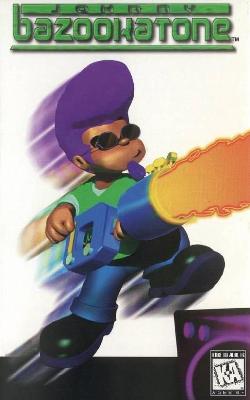
Johnny Bazookatone is a platforming video game developed by Arc Developments and published by U.S. Gold for the 3DO, PlayStation, Sega Saturn, and MS-DOS computers in 1996. Some releases also came equipped with a music CD based on the game's musical score. The game follows the protagonist, Johnny Bazookatone, trapped in the year 2050 in Sin Sin Prison by El Diablo, lord of the underworld. His guitar, known as "Anita" is taken from him, and so Johnny must travel to reclaim it.

Road Rash is a 1994 racing and vehicular combat video game originally published by Electronic Arts (EA) for the 3DO Interactive Multiplayer. A version for the Sega CD was developed simultaneously and released in 1995 to act as a "bridge" between the 3DO version and the Sega Genesis title Road Rash 3, and the game was subsequently ported to the PlayStation, Sega Saturn, and Microsoft Windows in 1996. The game is the third installment in the Road Rash series, and is centered around a series of motorcycle races throughout California that the player must win to advance to higher-difficulty races, while engaging in unarmed and armed combat to hinder the other racers.
